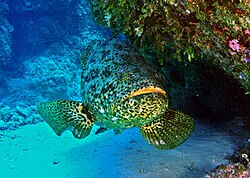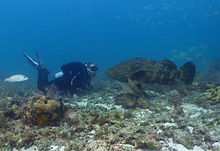| Atlantic goliath grouper | |
|---|---|
 | |
| Conservation status | |
 Critically Endangered (IUCN 3.1)[1] Critically Endangered (IUCN 3.1)[1] | |
| Scientific classification | |
| Kingdom: | Animalia |
| Phylum: | Chordata |
| Class: | Actinopterygii |
| Order: | Perciformes |
| Family: | Epinephelidae |
| Genus: | Epinephelus |
| Species: | E. itajara |
| Binomial name | |
| Epinephelus itajara (Lichtenstein, 1822) | |
Description
Young Atlantic goliath grouper may live in brackish estuaries, canals, and mangrove swamps, which is unusual behavior among groupers.
Until a harvest ban was placed on the species, its population was in rapid decline. The fish is entirely protected from harvest and is recognized as a critically endangered species by the International Union for Conservation of Nature (IUCN).[1] The US began protection in 1990, and the Caribbean in 1993. The species' population has been recovering since the ban; with the fish's slow growth rate, however, it will take some time for populations to return to their previous levels. Many conservationists are concerned that size-selective harvesting (seeking large fish and throwing back the small ones) may have inadvertently selected for smaller size, and fish of the size encountered so often in the mid-20th century may be lost forever[citation needed].
Goliath grouper eat crustaceans, other fish, octopuses, young sea turtles, sharks, and barracudas.
Reproduction
Goliath groupers are believed to be protogynous hermaphrodites, with individuals first maturing as females and only some large adults becoming males. Most grouper follow this pattern, but it has not yet been verified for the goliath.[3] In fact, Bullock et al. found males could be sexually mature at smaller sizes (~1150 mm) and younger ages (4–6 years) than females (~1225 mm and ~6–8 years).[4]Terminology
The common name of the goliath grouper is jewfish but, in 2001, the American Fisheries Society stopped using that terminology due to the potentially offensive nature of the name.From Wikipedia, the free encyclopedia
More News: www.whazzup-u.com
No comments:
Post a Comment